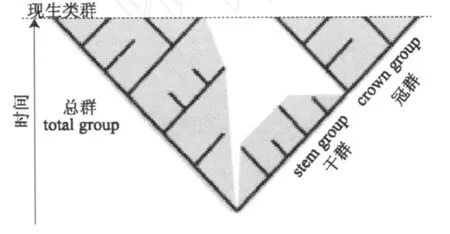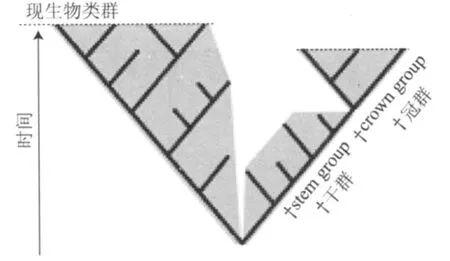古生物学术语冠群和干群的释义问题
2010-01-04薛进庄张华侨
薛进庄 张华侨
(北京大学地球与空间科学学院,北京 100872)
古生物学术语冠群和干群的释义问题
薛进庄 张华侨
(北京大学地球与空间科学学院,北京 100872)
对冠群和干群的概念沿革进行了回顾,认为应该遵从这两个术语的原始定义,对其释义的改变不利于学术交流。
冠群,干群,分支系统学
冠群 (crown group)和干群 (stem group)是两个非常重要的概念和术语,无论是在古生物学 (paleontology)还是在今生物学 (neotology)研究中都有着很广泛的使用[1]。在 Thomson Reuters公司的 ISI Web of Knowledge数据库中,以“主题 =(‘crown group’)or主题 =(‘stem group’)”为检索项,可检索到近 5年来 (2006.1—2010.5)涉及这两个术语的文献 300多篇。中文文献中,crown group一般被译为“冠群”[2-5]。一些学者将 stem group译为“基群”[2],而另一些学者及《古生物学名词 (第二版)》将其译为“干群”[3-5]。“基群”的译法容易与另一常见概念——basal group的译名 (多译为“基部类群”)混淆,因此笔者建议将 stem group统一译为“干群”。
对于冠群和干群这两个术语,文献中有 3种不同的释义:
1.分支系统学的奠基者、德国昆虫学家 Hennig[6]最早创立了“*group”(*群)和“stem group”概念。他以昆虫纲毛翅目 (Trichoptera)为例,把毛翅目中来源于最近共同祖先种的所有现生后裔形成的单系群,称为*毛翅目 (“When I want to refer only to the more restricted monophyletic group within the Trichoptera that contains all the descendants of the latest common stem-species of all recent species,I shall call it the*Trichoptera”)。而把属于毛翅目但又不属于*毛翅目的化石类群,称为毛翅目的干群 (“I shall refer to fossils that belong to the Trichoptera,but cannot be shown to belong to the*Trichoptera,as the stem-group of the Trichoptera”)。
其后 Jefferies[7]提出 crown group一词,用于代替Hennig的*群(*group),指一个支系中所有现生成员的最近共同祖先,以及这个祖先的所有后裔(“...comprise the latest common ancestor of all living members of group 1,plus all descendants of this ancestor,whether these are livingor extinct”[7])。冠群的定义中,强调了现生生物类群,但在冠群中,也可以包含绝灭类群。干群(stem group)指“在冠群之外但又与该冠群有更密切的系统发育关系、现已绝灭的生物类群”[2,7]。以上对冠群和干群的定义,是目前广为学术界所接受、使用最为广泛的定义,也为一些公众影响力较大的网站所接受(如W ikipedia)。另外, Jefferies[7]新拟了一个术语——total group(可译为“总群”[2]),用于指代冠群和干群的总合(图 1)。

图 1 冠群、干群和总群的含义 (依据文献[1,7])
2.为了更好地把化石类群加入到分类体系中, Monks于 2002年[8]主张在 crown group和 stem group前分别加前缀“†”,以 †crown group(†冠群)表示一个具共同衍征、但没有现生后裔的支系(“the†crown group being a clade defined by synapomorphies butwhich gave rise to no descendants”[8]),即化石记录中已经绝灭的单系群;†stem group(†干群)由一特定 †冠群的相继紧邻的姐妹群组成,但它本身不构成一个支系(“A†stem group is a branch of a phylogenetic tree which comprises the immediate sister groups of a given†crown group but is not itself a clade”[8])(图 2)。Monks的这一主张没有得到学术界的认可,另外,前缀“†”的增加并不能给学术交流带来便利[1]。

图 2 †冠群、†干群的含义 (依据文献[8])
3.在 2009年出版的《古生物学名词 (第二版)》中,冠群被解释为:“一个共同祖先及其所有后裔组成的单系群,即构成一个冠部类群。形成于一次分支发生事件,其识别依据是共同衍征。”[5]干群被解释为:“所有先于其冠部类群的共同祖先出现,并与冠部类群密切相关的化石种,它们构成该冠部类群的基干类群。”[5]这种解释与加州大学古生物博物馆(UCMP;University of California Museum of Paleontology)提供的术语解释[9]较为一致,他们将 crown group解释为“All the taxa descended from a major cladogenesis event,recognized by possessing the clade's synapomorphy”,将 stem group解释为“All the taxa in a clade preceding a major cladogenesis event.They are often difficult to recognize because they may not possess synapomorpies found in the crown group”。
第三种定义不强调现生生物类群与化石生物的对应,而是把谱系树上任意一个分支节点之上、具共同衍征的单系群称为冠群,而把位于该节点之下、与冠群关系密切的类群称为干群。尽管这样可能会给化石类群的研究带来一定的方便,但第一,这种定义与 Jefferies[7]最早提出的原始定义有别(即第一种定义),会造成学术界的误解;第二,如果只强调“一次分支发生事件”,而不强调“现生成员”,那么所有的单系群都可以称为冠群,这样事实上,会使得“冠群”与另一个术语——“单系”(monophyly[5-6];分支系统学的核心概念)表达的是同一个意思,冠群就成为一个冗余的概念。因此笔者建议应坚持冠群与干群的原始定义,以避免给未来的研究带来混乱。
[1]Donoghue P C J.Saving the stem group:a contradiction in ter ms[J].Paleobiology,2005,31(4):553-558.
[2]肖书海.斯芬克斯谜一般的节肢动物化石 [J].科学通报,2004,49(10):915-916.
[3]韩健,舒德干,张志飞等.早寒武世澄江化石库中鳃曳形目的早期祖先 [J].科学通报,2004,49(16):1644 -1652.
[4]路安民,汤彦承.被子植物起源研究中几种观点的思考[J].植物分类学报,2005,43(5):420-430.
[5]古生物学名词审定委员会.古生物学名词 (第二版) [Z],北京:科学出版社,2009.
[6]HennigW.InsectPhylogeny[M],NewYork:JohnW iley &Sons,1981.Translated and edited by Pont A C,from HennigW,Die Stammesgeschichte der Insekten,Senckenberg-Büch,1969,49:1-436.
[7]Jefferies R P S.The origin of chordates—A methodological essay[G]//HouseM R(Ed.).The origin ofmajor invertebrate groups.London:Academic Press,1979:443-477.
[8]Monks N.Cladistic analysis of a problematic ammonite group:the Hamitidae(Creataceous,Albian-Turonian)and proposals for new cladistic ter ms[J].Palaeontology,2002, 45:689-707.
[9]UCMP Glossary ofNaturalHistory Ter ms,Volume 1,Phylogenetic Terms[EB/OL].http://www.ucmp.berkeley. edu/glossary/glossary_1.html.
Definition of T wo Paleontological Terms:Crown Group and Stem Group
XUE Jinzhuang ZHANG Huaqiao
The authors review ed the his tory of concep ts of c row n g roup and s tem g roup,and sugges ted tha t the orig ina l definition of these tw o te rm s should be follow ed,and any la te r changes of the concep ts m ay not be benefic ia l for sc ientific comm unica tions.
c rown g roup,s tem g roup,c lad is tic
No4;Q91
A
1673-8578(2010)04-0057-03
2010-06-08
薛进庄(1981—),男,北京大学地球与空间科学学院讲师,主要研究泥盆纪植物的形态、解剖和系统学。通信方式:pkuxue@pku.edu.cn。
